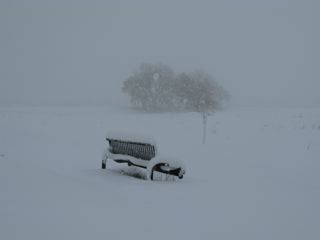A tricky relationship: El Niño and Colorado snow
Oct 28, 2009 - by Staff
Oct 28, 2009 - by Staff
Bob Henson • October 28, 2009 | As a major storm approached Colorado earlier this week, computer models disagreed at first on whether the Denver area would get a heavy snowstorm or a fairly light hit. I sensed this might be a big one—and indeed it was. As of 6 p.m. MDT on Wednesday 10/28/09, Boulder’s official observing site had recorded 16.7 inches, with more on the way.
In fairness, my intuition got a big boost from a recent arrival: El Niño.
Northeast Coloradans know major snowstorms well. What’s less known is that the presence of El Niño boosts the odds of a big dump considerably, even though our winters as a whole aren’t substantially wetter during El Niño. It’s a good example of nuance in the relationship between El Niño and climate, the kind of connections worth exploring in many parts of the world.
Update • July 1, 2015 | Matt Kelsch, an associate scientist at UCAR’s COMET Program, is one of Boulder’s two cooperative weather observers. Using snow data from 1950 to spring 2015, he's categorized the biggest storms, based on whether they occurred in periods classified as El Niño or La Niña (which each occur about 25% of the time) or neutral (the other half of the time).
Take a look at the table below: the bigger the dump, the more likely it is to have occurred during El Niño. Almost half of the 12" to 14" snowstorms in Boulder took place during an El Niño, but only 20% came during La Niña. The connection gets even tighter for heavier storms. From the table, you can infer that a storm dropping at least 20 inches (50 cm) is almost three times more likely during El Niño than during La Niña.
Accumulation |
≥ 12" |
≥ 15" |
≥ 20" |
| La Niña | 12/60 (20%) | 05/33 (15%) | 03/15 (20)% |
| Neutral | 20/60 (33%) | 12/33 (36%) | 04/15 (27%) |
| El Niño | 28/60 (47%) | 16/33 (48%) | 08/15 (53%) |
|
Number and percentage of 12-inch, 15-inch, and 20-inch snowfalls in Boulder from 1950 through spring 2015 that occurred during La Niña, neutral, or El Niño conditions. (Data courtesy Matt Kelsch, UCAR/COMET, updated July 1, 2015) |
|||
Most of these monster storms occur in the fall and spring, when there’s more moisture present than in midwinter but when temperatures are still cold enough for snow and ice. Two epic, airport-closing snowstorms—in December 1982 and October 1997—occurred during the two biggest El Niños of the last century. Two more recent big storms, March 2003 and December 2006, occurred with weaker El Niños.
 Snowfall in Louisville, Colorado, October 28, 2009
Snowfall in Louisville, Colorado, October 28, 2009
Digging deeper into snow trends
You might not guess that El Niño was so well correlated with big autumn and spring snows in northeast Colorado if you simply looked at national maps of typical impacts. These do give the flavor of how seasonal averages can shift during El Niño and La Niña. However, they’re not designed to capture temporal and spatial subtleties.
Consider this: NOAA’s Climate Prediction Center finds that November-December, taken as a whole, is just as likely to be on the dry side as on the wet side during El Niño across Denver’s climate zone (the Platte River Basin, region 4 in the linked map). A single big storm surrounded by dry spells could leave a two- or three-month period close to or even below average, obscuring the impact of that one big storm.
At NOAA's Earth System Research Laboratory, Klaus Wolter is issuing experimental seasonal outlooks for Colorado each month that incorporate the El Niño/Southern Oscillation (ENSO) and other data. He notes the tendency for Front Range snowfall to be particularly concentrated in the fall and spring during El Niño, with midwinters typically on the dry side.
El Niño = California flooding? Not always
Meteorologists elsewhere have fleshed out interesting local angles on ENSO. Jan Null, a former National Weather Service forecaster now at Golden Gate Weather Services, has related ENSO to California rainfall.
“With the exception of the strongly positive rainfall anomaly in Southern California during strong El Niños,” he says, “the presence of either El Niño or La Niña is not a guarantee of either a significantly wet or dry year in California.” The connection to flood damage is even more tenuous, according to Null.